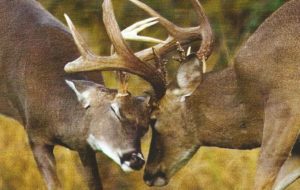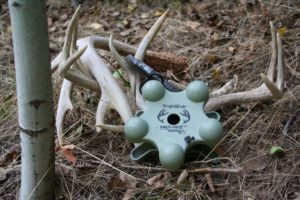30 Jun RATTLE RIGHT!!!

Back in the day when I was a young archer, using a wooden recurve bow, I tried rattling. While sitting in a tree stand one evening, a 6-point whitetail was about 100 yards away. There was no way he was going to come my way. I remember watching a deer hunting show about Texas Rattling. Since I had no horns or rattle gear, I instead started knocking my wooden arrow shafts together. The buck lifted his head and bee-lined calmly to my stand. Once in range, he stopped behind a tree, a bush, and a snag offering no shot. After he left, I called that buck in 3 more times. He never spooked or presented me a shot. The point is that rattling works.
If you can see a buck, he will be able to hear you. Stand position is important. Make sure you place your stand in a position that offers calling distance to bedding areas, travel zones and trails. You may need to compromise a bit on your location, but the point is to bring the buck to you.
Other factors need to be in place as well. Scent, cover scent, camo, and volume are all a part of the formula. Use your favorite scent system and use them during the right times. Doe in heat and other scents used at the wrong time will spook a smart buck.
Rattling works best in areas with less hunting pressure and low buck populations. A smart buck will hear you 3 times, see you twice, but smell you once. Hunt smart and scent free. Remember that you are in the bucks living room and they will smell, hear, and see you coming.
Not all areas have high buck densities. These areas make rattling a great choice. First locate the prime feeding areas. A Big Buck must eat. If you are finding fresh sign, look for the trails being used. These trails will lead to the bucks bedding areas. Older bucks seem more willing to travel uphill from their bedding area when rattled in. They also use no trails or little used trails.
Locate a tree stand site that allows you stealthy access, cover, and has low lying thick areas nearby. You may also find fresh rubs and scrapes along the perimeter of these areas. Deer are creatures of edges and transitions between thick and open areas. Older, big bucks did not get that way by being stupid. They are wise and learned from mistakes.
Scent is also important. Rattling in a buck must attract more than a bucks hearing. If they also smell another buck, it will reinforce your calling and rattling. Breaking branches and leaf noise also helps. Thrashing branches and limbs also compliments other calling.
Place your scent bombs out a hundred yards off each side of your stand. Hang them just a few feet above the ground, perpendicular to the prevailing wind direction. Use a scented drag back to your stand. A cover scent is also important for the hunter. Hang the scent rags where you expect your best shot to be. You will be amazed how many deer you will tag that were sniffing the rag.
Move easily and slowly. If you know your stand area, do this before daylight. Usually the cooler morning temps will keep you from sweating and producing excessive body scent. A blue or red flashlight will help and not distract deer like a bright white flashlight. Any buck hitting that scent line will travel toward your stand. Some light rattling, or calling, will seal the deal, if you see the buck first.
Always be alert and look for deer when calling. Things will happen quickly. If you are surprised, the buck often will escape. Binoculars are essential when deer hunting. Constantly scan for a deer. You will rarely see a whole deer. Look for a part of a deer or movement. Bucks will often travel just a few feet inside the cover. Once you see the buck, rattling and calling will help to entice them in your direction.
Rattling, alone, will not always work. Many hunters try to rattle too loud and too much. Bucks hear very well. Call and rattle softly and naturally. Look for any reaction from the buck. I have often seen bucks do nothing but ignore my calls. Later, they end up under my tree stand without me knowing until too late. If you rattle and call in a 10-foot hole, the buck will hear you and know your location. They just may not be in the mood. Timing is everything. The same situation a few days later will result in a different outcome. The good news is that you will rarely spook a buck when calling. The sounds you create mimic natural and normal deer sounds.
During the peak rut, bucks frequently spar, or make the rattling noise. Most of these episodes are brief. Dominance is decided quickly. Younger bucks will keep testing older bucks for breeding rights. Bigger bucks lose patience and become more aggressive. This is when softer rattling really pays off. Mimic the sounds that you hear. Simulate an encounter using your horns and calls. Tell a story about what is going on.
It is not uncommon for bucks to run into your stand area. If you hear and see them coming, other bucks may also be involved. Stay alert and ready to shoot. Grunt to stop the buck in range.
Does will often give the location of a buck away. Watch where the does are looking. Bucks are often lurking just out of sight back in the cover or chasing them. If you begin calling with a doe in sight, she will act as the perfect decoy. The scent that you put out will also help to lead bucks to your stand site.
Rattling and calling work when they work. Like all hunting tactics, timing and location are critical. When these strategies work, it is amazing. Other smells, hunters, distractions, predators, wind and weather changes will ruin your perfect setup.
That’s why it’s called hunting.
Montana Grant
For more Montana Grant. Hunt him up at www.montanagrantfishing.com.



